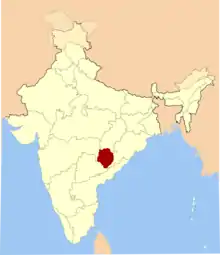Halbi language
Halbi (also Bastari, Halba, Halvas, Halabi, Halvi) is an Eastern Indo-Aryan language, transitional between Odia and Marathi.[2] It is spoken by 500,000 people across the central part of India.
| Halbi | |
|---|---|
| हलबी, ହଲବୀ | |
| Native to | India |
| Region | Madhya Pradesh, Chhattisgarh, Andhra Pradesh, Orissa and Maharashtra |
| Ethnicity | Halba |
Native speakers | 766,297 (2011 census)[1] |
| Devanagari, Odia | |
| Language codes | |
| ISO 639-3 | Either:hlb – Halbibhu – Bhunjia |
| Glottolog | halb1244 Halbibhun1242 Bhunjia |
| Linguasphere | 59-AAF-tb |
 Halbi-speaking region | |
The Mehari (or Mahari) dialect is mutually intelligible with the other dialects only with difficulty. There are an estimated 200,000 second-language speakers (as of 2001). In Chhattisgarh educated people are fluent in Hindi. Some first language speakers use Bhatri as second language.
Halbi is often used as a trade language, but there is a low literacy rate. It is written in the Odia and Devanagari scripts. It uses SOV word order (subject-object-verb), makes strong use of affixes, and places adjectives before nouns.
Phonology
Vowels
Halbi has 6 vowels: /a, e, ɘ, i, o, u/. All vowels show contrastive vowel nasalization.[3]
References
- "Statement 1: Abstract of speakers' strength of languages and mother tongues - 2011". www.censusindia.gov.in. Office of the Registrar General & Census Commissioner, India. Retrieved 2018-07-07.
- Masica (1991)
- "PHOIBLE 2.0 -". phoible.org. Retrieved 2020-03-16.